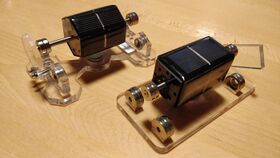Mendocino motor
Topic: Engineering
 From HandWiki - Reading time: 4 min
From HandWiki - Reading time: 4 min
The Mendocino motor is a solar-powered magnetically levitated electric motor. With a very low power output, they are generally used as technical demonstrations only, but are a popular construction project with electronic enthusiasts.[1]
Description

The motor consists of a rotor shaft with an array of (typically four to eight) solar panels and electromagnetic coils arranged in a barrel shape around the centre of the shaft; this rotor is horizontally mounted in a frictionless radial bearings over a central magnet on the base plate of the motor. The final 6th degree of freedom, the axial or thrust direction, is not levitated, but rather supported by a steel ball point of contact (low friction).
An original Mendocino Motor is a light commutated motor. Two opposite solar panels are connected plus to opposite minus and minus to opposite plus. A coil is switched between these bridges. The solar panel in the sun/light produces more electricity than the solar panel in the shadow. So the solar panel in the sun dominates the flow of electricity. The coil and the base magnet create Lorentz force and so a movement that leads the next solar panel into the sun/light, thus maintaining the rotation. If the rotor is well balanced the rotor will start itself with enough light. Even a candle light could start a very well balanced rotor.[2][3]
In a modification, new constructors used one coil each supported by one opposite solar panel. It's easier to produce but this design isn't as favorable as the light commutated version. Many of these motors need an initial impulse to move.
History
The idea of a light-commutated motor, where solar cells power the individual coils of a motor, was first described by Daryl Chapin in an experiment kit from 1962 about solar energy.[1] The kit was distributed by Bell Labs, where Chapin together with his colleagues Calvin Fuller and Gerald Pearson had invented the modern solar cell eight years earlier, in 1954.[4] Chapin's version of the motor uses a vertical glass cylinder on a needle point as a low-friction bearing.
A magnetic suspension of the rotor was added in 1994 by eccentric inventor Larry Spring to create "Larry Spring's Magnetic Levitation Mendocino Brushless Solar Motor"[5] - more commonly called "Mendocino Motor" with a horizontal rotor. The name comes from the location of his workshop on the Mendocino coast of California.[5]
References
- ↑ 1.0 1.1 Daryl M. Chapin (1962). Bell System Science Experiment No. 2: Energy from the Sun. Bell Telephone Laboratories, Incorporated. p. 77.
- ↑ Wang, Yo (2020-05-01). "【Fun Science】The Mystery of the Mendocino Motor (Perpetual Motion Machine?)" (in zh-tw) (video). Taiwan: Youtube. https://www.youtube.com/watch?v=9LH6QHrEdo4.
- ↑ Wang, Yo (2020-11-06). "Mendocino Motor Type-A (Made for Beyond Torii Type)" (in zh-tw) (video). Taiwan: Youtube. https://www.youtube.com/watch?v=YLpnICgYWLM.
- ↑ "Bell System Memorial: Bell Labs Science Kits (Energy From The Sun)". http://www.porticus.org/bell/belllabs_kits_se.html. Retrieved 2009-11-24.
- ↑ 5.0 5.1 Berger, Kévin. "Solar Electric Motor on Superconducting Bearings: Design and Tests in Liquid Nitrogen". IEEE Transactions on Applied Superconductivity, Institute of Electrical and Electronics Engineers. https://hal.archives-ouvertes.fr/hal-01398145/document. Retrieved 29 May 2019.
External links
 |
 KSF
KSF
